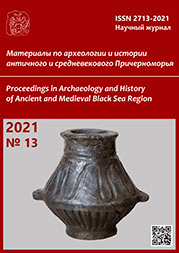Македонская (фракийская ?) бронзовая патера из кургана № 1/1910 группы «Частые курганы» на Среднем Дону
A Macedonian (Thracian?) bronze patera from the Burial-mound no. 1/1910 of the Chastye kurgany-group in the Middle Don Region
Author(s): Mikhail Ju. TreisterSubject(s): History, Archaeology, Cultural history, Ancient World
Published by: Нижневартовский государственный университет
Keywords: Scythian Burial-mounds; Middle Don region; Macedonian and Thracian bronze vessels; pateras; Herakles; Gorgo; Alexander of Macedon; iconography;
Summary/Abstract: The publication is dedicated to a bronze vessel found in a robbed burial of the second half of the 4th century BCE in the Burial-mound no. 1 of the Chastye Kurgany group on the outskirts of Voronezh, excavated by the Voronezh Scientific Archive Commission in 1910. A vessel with a handle attachment in form of a mask under the edge on the outside and a gorgoneion-medallion at the bottom inside is a patera with a handle lost in antiquity. Such pateras with similarly shaped edges of the bowl and handles ending in a ram's head are known after a very small number of finds of the second half of the 4th century BCE almost all of which come from Macedonia and Thrace. Given the fact that lion's paws are depicted on the sides of the neck of the person shown on the mask, there is every reason for its attribution as the head of Herakles. A similar iconography is typical for vessel attachments from Northern Greece. The treatment of hair strands, in particular symmetrical curls over the forehead (anastole / ἀναστολή), resembles the hairstyle in the portraits of Alexander the Great and imitations of them. Taking into account this observation, it is hardly possible to date the patera from Chastye kurgans earlier than the last quarter of the 4th century BCE. In the North Pontic region, bronze vessels of this shape have not yet been known, despite the fact that the finds of bronze vessels of the Macedonian-Thracian circle of the 4th century BCE are represented both in Scythia and in the Bosporus. Taking into account the known finds of bronze vessels of the Macedonian types at the Elizavetinskoe fortified settlement and in its necropolis at the mouth of the Don, it can be assumed that such vessels could have reached the Middle Don in this way. At the same time, given the relative rarity of bronze (silver) pateras in Macedonia and Thrace in the second half of the 4th — early 3rd century BCE and their finds in very rich complexes, including in the royal burials in Vergina and Golyamata Kosmatka, one cannot exclude the possibility of a different way for the patera from Chastye Barrows. In Macedonia and Thrace, such pateras, together with the oinochoai, were part of the banquet sets, therefore, in this case, the patera, which, perhaps, originally had a pair (oinochoe) could also be a diplomatic gift. In any case, the patera from Chastye Burial-mounds fits into the circle of finds of Thracian horse-bridle pieces and Thracian and Macedonian toreutics found in the burials of the Scythian nobility in the Middle Don region.
Journal: Материалы по археологии и истории античного и средневекового Причерноморья
- Issue Year: 2021
- Issue No: 13
- Page Range: 380-403
- Page Count: 24
- Language: Russian

